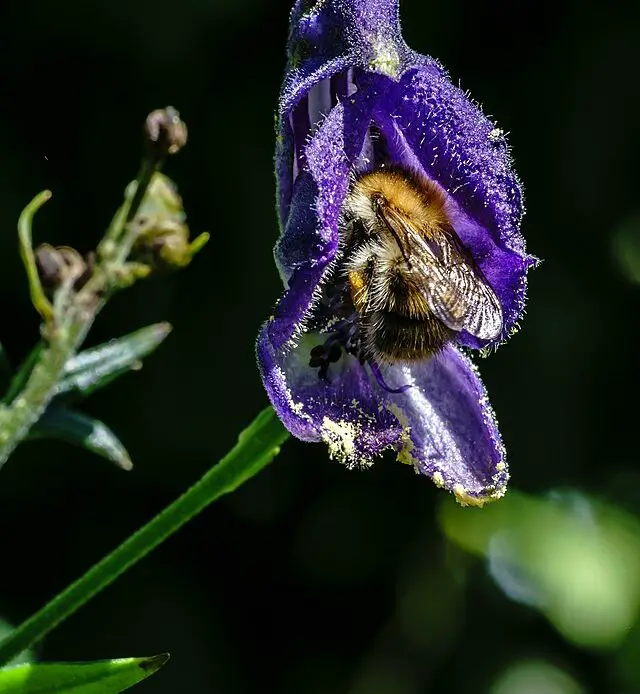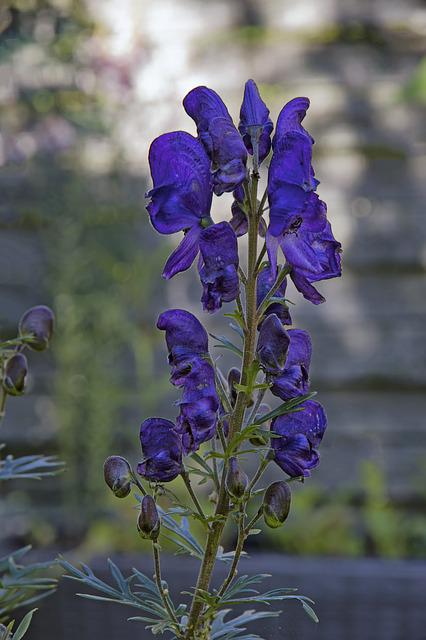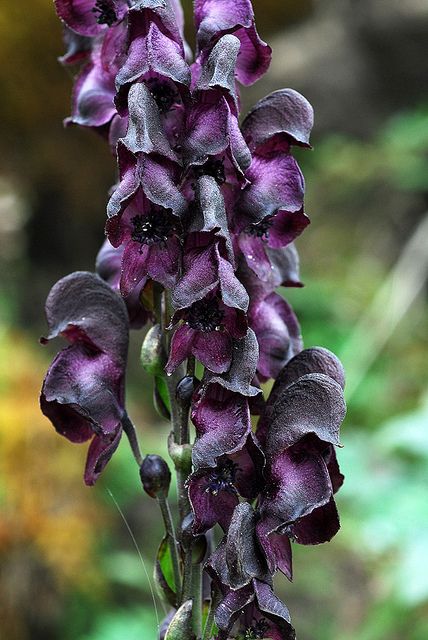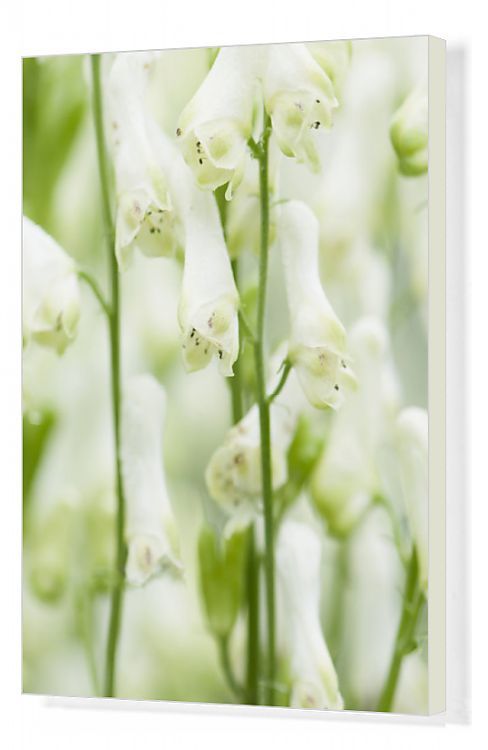
Last updated on May 20th, 2023 at 02:13 pm
Known by some of the most glamorous monikers, this herbaceous perennial plant has a fairly colorful history.
Some of the more famous and intriguing titles for this flowering plant include ‘Wolfsbane,’ ‘Monkshood,’ and ‘queen of poison.’ However, its scientific name, Aconitum, is possibly a derivative of a Greek word meaning Javelin. Spears, darts, and Javelins used to be poisoned by aconite and used to hunt wolves. The name monkshood refers to the tubular covering of the flower that looks like the hoods monks wore in Europe.
Aconite grows naturally in the hilly regions of North America, Europe, and Asia: it grows in soil that holds moisture but drains well. Mountainous meadows, such as the mountains where the plants are native, are what aconite needs to flourish.
Scientifically known as Aconitum, the plant is a genus that includes over 250 flowering plants.
The plant is fairly dangerous, even though it is cultivated and has won multiple gardening awards. Aconite is a powerful neurotoxin that can be fatal if ingested directly. It can paralyze the heart and cause numbness and motor frailty, among other symptoms.
What does the Aconite (Wolfsbane) flower symbolize?
Death is the most common symbol in mythology or stories about the beautiful flowering plant. This is not surprising, considering that it is an extremely poisonous plant.
Thus, due to such an association, aconite (wolfsbane) flowers symbolize madness. These flowers have been linked with nerves, anxiety, and delusions since immemorial. Medieval doctors even prescribe poison as a remedy for such delusions, which in many cases led to the patient’s death.
According to the myths of Greek culture, aconite was produced from the saliva dripping from the three-headed dog that guarded the gates of hell. Aconite flowers started to bloom from where the saliva of this dog hit the ground.
This flower was an integral part of witches’ brew in folklore. During the Dark Ages, people had begun to associate aconite flowers with werewolves. They feared that it caused someone to turn into a werewolf or cure the phenomenon.
The famous English playwright Shakespeare has referred to the toxicity of aconite flowers in many plays, including Henry IV and Hamlet. Poets like Keats mentioned wolfsbane as a poisonous vine in Ode on Melancholy.
In movies, aconite flowers were depicted as offering protection against all sorts of vampires.
But the most contemporary of references comes from the famous series, Harry Potter, where the flower is used in a magic potion.
No surprise that aconite flowers served as the perfect weapon of choice for murder plots in various crime and suspense novels and movies.
All in all, the aconite (wolfsbane) flowers symbolic meanings are:
- death
- deceit
- murder
- dark magic
- gloomy Moorish misanthropy
Meaning of the Aconite (Wolfsbane) flower colors
Yellow color

Technically classified as Aconitum Anthora, this particular plant yields soft yellow flowers. Though they may look innocent, like all queens of poison, these flowers aren’t.
Yellow as a color signifies warmth and creativity. However, it also represents deception and caution—two of which have been linked with aconite flower meanings. This makes a yellow aconite (wolfsbane) flower even more malicious, as its bright exterior hides a dangerous outcome.
In many ways, the yellow aconite flower’s meaning can be seen as a special warning. It is a warning that even when all looks beautiful and well, that is not the case, and caution is to be practiced.
This flower color signals friendship, love for a sibling, or for that matter, to a colleague, if you want to show appreciation for their work.
Blue color

Also known as Carmichael’s Monkshood, these plants mostly grow in eastern Russia and Asia. The plant was known to Chinese herbalists as the Fu Zi and was used to treat various medical conditions.
This blue variety in the list of aconite (wolfsbane) flower meanings does check the more positive ones. It symbolizes healing, ancient medicines, etc.
However, the blue color and the disorders the plant treats connect the aconite flower meanings to depression and anxiety—in other words, feeling ‘blue.’
This flower color is associated with a deep and abiding feeling of trust. Sometimes it creates a feeling of sympathy and wishes the receiver a fast recovery.
Purple color

Purple or violet shades are quite common in aconite (wolfsbane) flowers. They can be found everywhere that aconite takes root.
Some species are used in Korean medicine to treat aches and pains; others are used for ornamental purposes.
The purple variety symbolizes the darker aspects of wolfsbane. This color has long been associated with the mysteriously wicked to the point that Disney has long portrayed its witches or villains wearing purple.
Thus, the purple aconite flower’s meaning is a mystery, murder, poison, and witchcraft.
However, people find that their mood is elevated with purple flowers in their room.
A wise man avoids gifting purple wolfsbane flowers to his valentine for fear of creating mistrust and even hatred. Save this particular bouquet for your enemies.
White color

White aconite (wolfsbane) flowers are the way to go if you wish to convey elegance and innocence. They represent honesty, thoughtful love, and purity.
Interesting facts about the Aconite (Wolfsbane) flower
- Besides the wild varieties of the aconite (wolfsbane) plants, a few species, like A.henryi, and A.uncinatum, are also cultivated in gardens. But whether they are wild or cultivated, all species consist of aconitine, a powerful toxin.
- The monkshood variety, A. napellus, native to European mountains and the Himalayas, is the prime aconitine source. In ancient times, this toxin was given to people accused of a crime. It was also useful in reducing fever and treating severe nerve disorders in very small strengths.
- Even though there were certain therapeutic uses for wolfsbane, it wasn’t easy to control the dosage. This often led to adverse effects and toxicity. The drug causes serious heart disorders, generalized numbness, and stomach and breathing difficulties.
- Many civilizations like the Chinese, Indian, and ancient Europeans have long used Aconitum. The Greeks and Romans had developed poison for the first using aconite or wolf’s bane. It began to be widely used from then on for eliminating political opponents, in war, and most famously for hunting. The Chinese also tipped their arrowheads with aconite to hunt carnivores.
- When used in correct proportions, Aconitum could be beneficial. For instance, A.napellus reduces pain, especially in the joints. There have been records of using it as a topical paste to reduce fevers, to promote the healing of mild bruises.
- Diuretics and anti-inflammatory drugs have also been prepared using aconite flowers. The most important process to bring out these benefits and neutralize the toxin is boiling or cooking these flowers and other parts of the plant. This reduces the strength of the toxin and makes it suitable for traditional methods like Ayurveda, a well-established system of Indian medicine.
How to grow Aconite (Wolfsbane) flowers
The best time to plant aconite (wolfsbane) is in September to ensure proper root growth before the winter and healthy regrowth the following spring.
If you want to plant in the spring, you must water your plants frequently afterward.
- Aconite (wolfsbane) prefers many types of soil, including poor, dry soil.
- Before planting aconites, you are allowed to add compost or fertilizer.
- Aconite enjoys places with some sun and some light shade.
- Avoid areas where the plant has been staked or where the wind howls.
- Keep a 16-inch (40-cm) gap between plants.
- In the spring and fall, aconites can be multiplied through crown division.
- Sow seeds in the early spring.
How to care for Aconite (Wolfsbane) flowers
- Trim the stems after the aconite (wolfsbane) flowers bloom to encourage the growth of fresh blossoms.
- Trim the stems to the shortest length possible in the fall, and cover the plant’s base in colder areas.
- The tallest aconite species cannot withstand wind, so they require staking to prevent flopping.
- Aconites don’t need to be deadheaded.
- Maintain moist soil in the spring and dry soil in the summer.
Best time to gift Aconite (Wolfsbane) flowers
Because aconite (wolfsbane) flower meanings are not the brightest, these flowers don’t make the best casual gifts and are usually not given as bouquets as they are toxic and cause severe reactions.
The dramatic colors of the aconite flowers are a grand addition to the spectacle of any garden. Due to its toxic nature, extreme caution was followed when gifting flowers like aconite. It signified treachery and advocated caution when given as a gift to someone. Perhaps people gifted these flowers to warn the recipient of any danger.
In the Victorian era, only people who disliked other human beings and avoided social interactions were suitable recipients and givers of the notorious wolfsbane flowers.
It is best to give the plant only to those who understand how to take care of poisonous plants. People with esoteric interests in witchcraft, and herbal medicines, might appreciate receiving such a gift.
However, when gifting something as dangerous as the queen of Poisons, it is always best to ask.
Conclusion
You might find the facts about aconite (wolfsbane) flowers very disturbing. However, they are very informative and certainly cannot harm the beauty of this flower.
The tall spires of wolfsbane can add dramatic color to your late-summer garden. This perennial’s yellow, blue, purple, and white flowers may be lovely, but every part of the plant is toxic, so care must be taken when planting or gifting aconite flowers.
If you want to know and learn more about flowers, we at PansyMaiden can help you. Check out our fun, easy-to-read, and informative flower-related content that you will surely enjoy!

